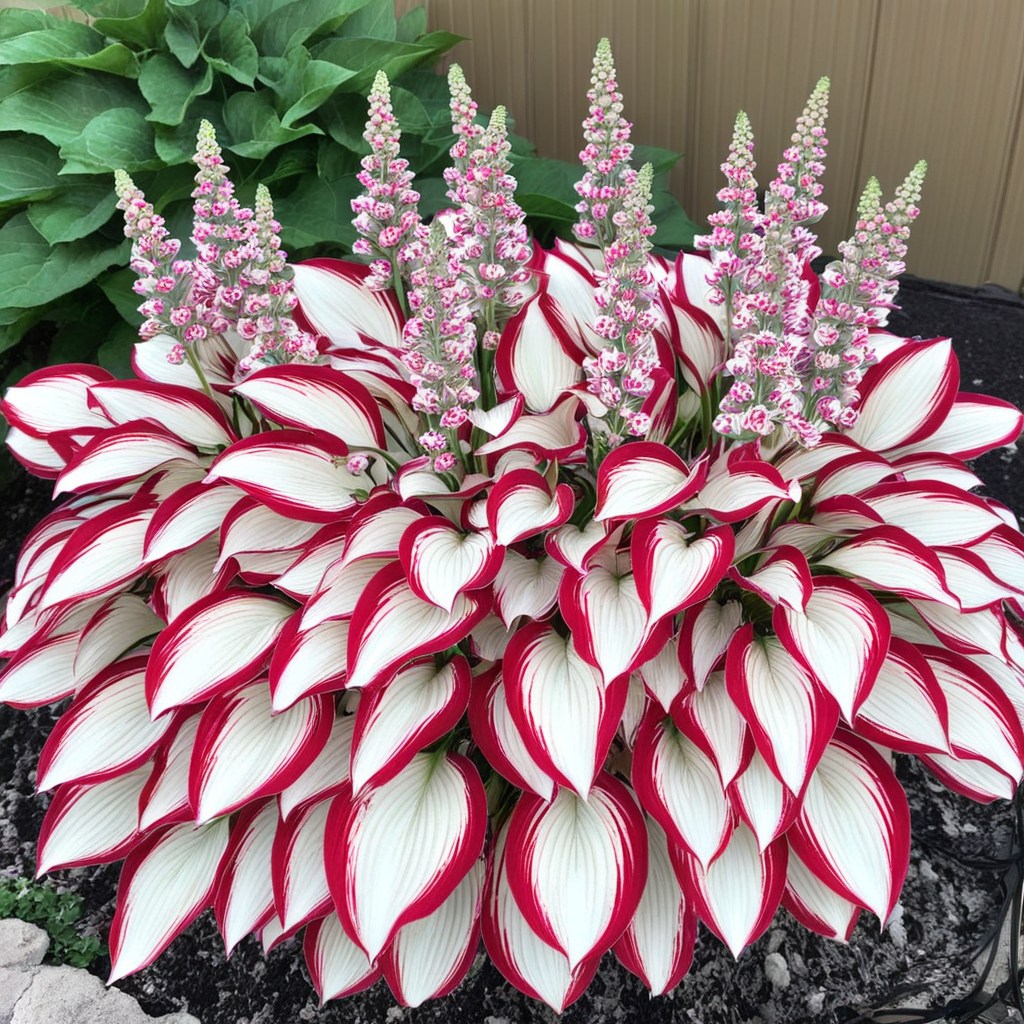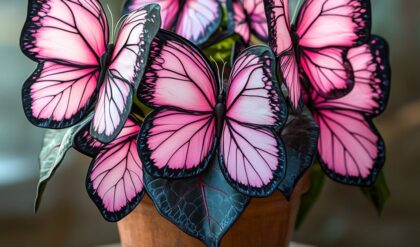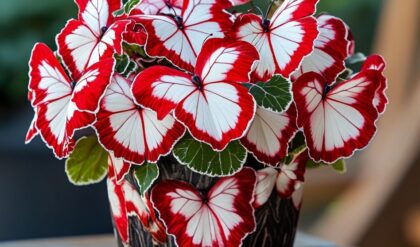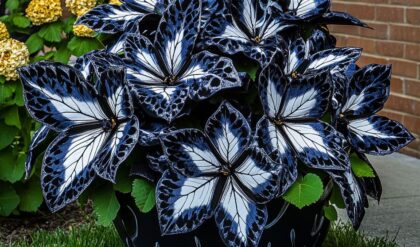In the realm of gardening, where nature’s canvas is our canvas, the giant variegated hosta stands as a true masterpiece. These captivating plants have the power to transform a shaded garden into a verdant oasis, where the vibrant contrast of colors and sizes captivates both the eye and the imagination. Embarking on the journey of growing these botanical wonders is akin to unlocking the secrets of nature’s artistry, a harmonious blend of science, patience, and an appreciation for the beauty that lies within.

The Right Environment for Growth
To achieve the stunning size that giant hostas are known for, it’s crucial to provide them with the right environment. Hostas thrive in rich, fertile soil that is abundant in organic matter yet drains well—think of it as giving them a luxurious bed to rest upon. A partial shade location is ideal, as too much sunlight can scorch their delicate leaves while too little may stunt their growth. This balance mirrors the intricacies of life; much like us, hostas flourish when given just the right amount of nurturing without overwhelming stress.
Soil Composition and Structure
The foundation of a thriving giant hosta garden lies in the soil. Hostas prefer a soil that is rich in organic matter, such as compost or well-rotted leaf litter. This not only provides essential nutrients but also enhances the soil structure, allowing the roots to spread effortlessly. Incorporating organic matter into the soil can be as simple as digging in a generous layer of compost or aged manure before planting. This act of nourishing the earth mirrors the care we must extend to ourselves, creating an environment that fosters growth and resilience.

The Importance of Shade
Striking the right balance between sunlight and shade is crucial for the health and growth of giant variegated hostas. These plants thrive in partial shade, which protects their delicate leaves from the scorching effects of direct sunlight. Too much exposure can lead to leaf scorch, where the edges of the leaves turn brown and crisp. Conversely, too little sunlight may result in stunted growth and a lack of vibrant coloration. By understanding the nuances of light exposure, gardeners can create a harmonious environment that allows their hostas to flourish, much like finding the perfect work-life balance for our own well-being.
Drainage and Moisture Regulation
In addition to the right soil composition and light exposure, proper drainage and moisture regulation are essential for the success of giant variegated hostas. These plants prefer well-draining soil that doesn’t become waterlogged, as their roots are susceptible to rot in overly moist conditions. Ensuring adequate drainage can be achieved through techniques such as incorporating organic matter, creating raised beds, or installing drainage systems. At the same time, keeping the soil consistently moist, especially during dry spells, is crucial for promoting vigorous growth. Imagine your hostas as thirsty athletes, needing hydration to reach their full potential.

Maximizing Size: Nutrients and Watering
Once you have established the perfect location, consider the nutritional needs of your giant variegated hostas. Incorporating compost into the soil not only provides essential nutrients but also enhances the soil structure, allowing roots to spread effortlessly. Regular watering is equally important, especially during dry spells, akin to quenching a thirst that fuels growth. Think of your plants as young athletes—they need hydration and nourishment to reach their full potential.
Feeding for Optimal Growth
Hostas are heavy feeders, requiring a steady supply of nutrients to support their impressive size and vibrant foliage. Incorporating a balanced, slow-release fertilizer into the soil at the beginning of the growing season can provide a steady supply of essential nutrients throughout the year. Alternatively, supplementing with compost or well-rotted manure can offer a more natural and sustainable approach to feeding your plants. Much like a balanced diet for our own well-being, this nourishment helps hostas reach their fullest potential.
Watering Strategies for Giant Hostas
Consistent and adequate watering is crucial for the growth and development of giant variegated hostas. These plants require about 1 inch of water per week, either from rainfall or supplemental irrigation. During periods of drought or extended dry spells, it’s essential to ensure the soil remains consistently moist, but not waterlogged. Applying a thick layer of organic mulch around the plants can help retain moisture and minimize the need for frequent watering. By meeting the hydration needs of your hostas, you’re nurturing their growth in the same way we care for our own physical and mental well-being.

Timing and Frequency of Watering
The timing and frequency of watering can significantly impact the success of your giant hosta garden. Aim to water in the morning or evening, when evaporation rates are lower, to maximize the absorption of moisture by the plants. Avoid watering during the hottest parts of the day, as this can lead to rapid evaporation and stress for the plants. Additionally, be mindful of the soil’s moisture levels and adjust your watering schedule accordingly. Hostas that are wilting or have dry, crispy leaves may indicate the need for more frequent watering, while overly soggy soil may require a reduction in watering frequency. Adapting to the unique needs of your plants, much like tailoring our own self-care routines, can lead to thriving and resilient giant hostas.
Choosing the Right Cultivars
The selection of hosta cultivars plays a pivotal role in achieving striking visual results. Varieties such as ‘Empress Wu’ or ‘Wu-La-La’ offer impressive dimensions and captivating color patterns. These particular cultivars are known to grow exceptionally large, making them star players in your garden design. Imagine pairing these giant beauties with smaller, contrasting plants to create a dynamic visual interplay—a garden choreography that delights every observer.
Identifying Promising Cultivars
When choosing giant hosta cultivars, look for varieties that are known for their impressive size and striking foliage patterns. Cultivars like ‘Empress Wu,’ ‘Wu-La-La,’ and ‘Sum and Substance’ are prized for their massive leaves and towering growth habits. These plants can reach dimensions of 3 feet or more in height and width, creating a bold and commanding presence in the garden. Additionally, consider cultivars with variegated leaves, as the interplay of colors can add depth and visual interest to your landscape.
Considerations for Cultivar Selection
Beyond size and foliage, other factors to consider when selecting giant hosta cultivars include sun tolerance, leaf texture, and growth habit. Some varieties, such as ‘Halcyon’ and ‘Blue Angel,’ thrive in partial shade, while others, like ‘Guacamole,’ can handle more sun exposure. Leaf texture can also vary, with some cultivars boasting thick, leathery leaves while others have a more delicate, ruffled appearance. Growth habit is another important consideration, as some hostas have a more upright, vase-like form, while others spread outward with a more cascading effect. By carefully considering these nuances, you can create a harmonious and visually stunning hosta garden that reflects your personal aesthetic.

Pairing Hostas with Companion Plants
When planning your giant hosta garden, consider incorporating complementary companion plants to enhance the overall visual impact. Smaller, contrasting plants can help frame and showcase the impressive size and foliage of your giant hostas. For example, planting low-growing perennials, such as sweet woodruff or creeping phlox, around the base of your hostas can create a lush, layered effect. Alternatively, using bold, textural plants, like ferns or ornamental grasses, can provide a striking contrast to the broad, soft leaves of the hostas. This interplay of sizes, colors, and textures mimics the natural harmony found in the wild, inspiring a sense of wonder and appreciation in all who behold it.
Embracing Nature’s Diversity
Interestingly, embracing the diversity among hostas can yield unexpected benefits. Some varieties do remarkably well with specific sun exposure adjustments, thriving under conditions tailored to their unique characteristics. For example, variegated hostas may prefer filtered sunlight, allowing their colors to pop while maintaining leaf health. This customization encourages us to learn from nature—the importance of understanding individual needs resonates not only in gardening but also in our interactions with one another.
Accommodating Varietal Preferences
Not all hostas have the same sun and shade requirements, and it’s important to understand the unique needs of each cultivar. Some varieties, like ‘Halcyon’ and ‘Blue Angel,’ thrive in partial shade, while others, such as ‘Guacamole,’ can handle more sun exposure. By observing the growth and color of your hostas, you can make adjustments to their placement in the garden to ensure they receive the optimal light conditions. This attention to detail mirrors the way we care for our loved ones, adapting our approaches to meet their individual needs and helping them reach their full potential.
Fostering Diversity in the Garden
Embracing the diversity of hostas can also lead to unexpected rewards in the garden. Planting a variety of cultivars, ranging from small to large and with different leaf patterns and colors, can create a visually captivating and dynamic landscape. This diversity mimics the richness of the natural world, where each species and individual contributes to the overall ecosystem’s health and resilience. By cultivating this tapestry of hostas, gardeners can foster an environment that is not only aesthetically pleasing but also resilient to environmental changes and pests.
Lessons in Adaptability
The varied needs and preferences of hostas can also teach us valuable lessons about adaptability. Just as some hosta varieties thrive in specific light conditions, we too can learn to adjust our own approaches to life’s challenges. By observing the ways in which hostas respond to their environment, we can apply those insights to our personal growth and development, becoming more attuned to our own unique needs and the unique needs of those around us. This adaptability, rooted in an appreciation for diversity, can lead to a more harmonious and fulfilling existence, both in the garden and in our daily lives.
Community Wisdom and Shared Experiences
Engaging with fellow gardeners can also be invaluable in your quest to grow giant variegated hostas. Online communities, such as Reddit’s gardening forums, often share personal experiences, tips, and tricks honed through trial and error. These shared narratives can offer insight into local conditions or pests that might affect your plants, inviting a collaborative spirit reminiscent of ancient agricultural practices where knowledge was passed down through generations. In essence, growing giant variegated hostas is more than just a gardening endeavor; it is a harmonious blend of art, science, and community.
Connecting with Gardening Communities
The internet has revolutionized the way gardeners connect and share knowledge. Online forums, such as those found on Reddit, have become vibrant communities where enthusiasts of all skill levels can come together to exchange insights, troubleshoot issues, and celebrate their successes. By engaging with these communities, you can tap into a wealth of collective wisdom, learning from the experiences of other giant hosta growers who have navigated similar challenges. This collaborative spirit harks back to the days when agricultural knowledge was passed down through generations, fostering a sense of unity and shared purpose.
Leveraging Local Expertise
In addition to online communities, connecting with local gardening groups or clubs can also be incredibly valuable when growing giant variegated hostas. These groups often have members who have extensive experience cultivating plants in your specific climate and soil conditions. By tapping into this localized expertise, you can gain insights into which cultivars are best suited to your region, how to manage pests and diseases common in your area, and strategies for overcoming unique growing challenges. This exchange of local knowledge creates a tapestry of shared experiences, much like the diverse ecosystem of a thriving garden.
Celebrating Shared Successes
As you navigate the journey of growing giant variegated hostas, sharing your triumphs and challenges with fellow gardeners can be a deeply rewarding experience. Celebrating the successful cultivation of these botanical wonders, whether it’s through online forums, local gatherings, or even social media, can foster a sense of community and mutual appreciation for the art of gardening. This shared sense of accomplishment resonates on a deeper level, reminding us that we are not alone in our pursuit of nurturing and appreciating the natural world. Just as the giant hostas in your garden thrive through the interplay of diverse elements, the gardening community can flourish through the exchange of ideas, support, and collective wonder.
Conclusion
Growing giant variegated hostas is more than just a gardening endeavor; it is a harmonious blend of art, science, and community. By carefully selecting the right cultivars, providing optimal growing conditions, and sharing experiences with fellow enthusiasts, you can cultivate a flourishing garden that stands as a lasting symbol of your dedication and passion for the natural world.
As you embark on this journey, remember that the key to success lies in understanding the unique needs of your hostas, embracing the diversity of nature, and fostering a sense of community. Just as these botanical wonders transform a shaded garden into a lush oasis, your journey with giant variegated hostas has the power to enrich your life, inspiring you to appreciate the intricate beauty that surrounds us and the interconnectedness of all living things.



